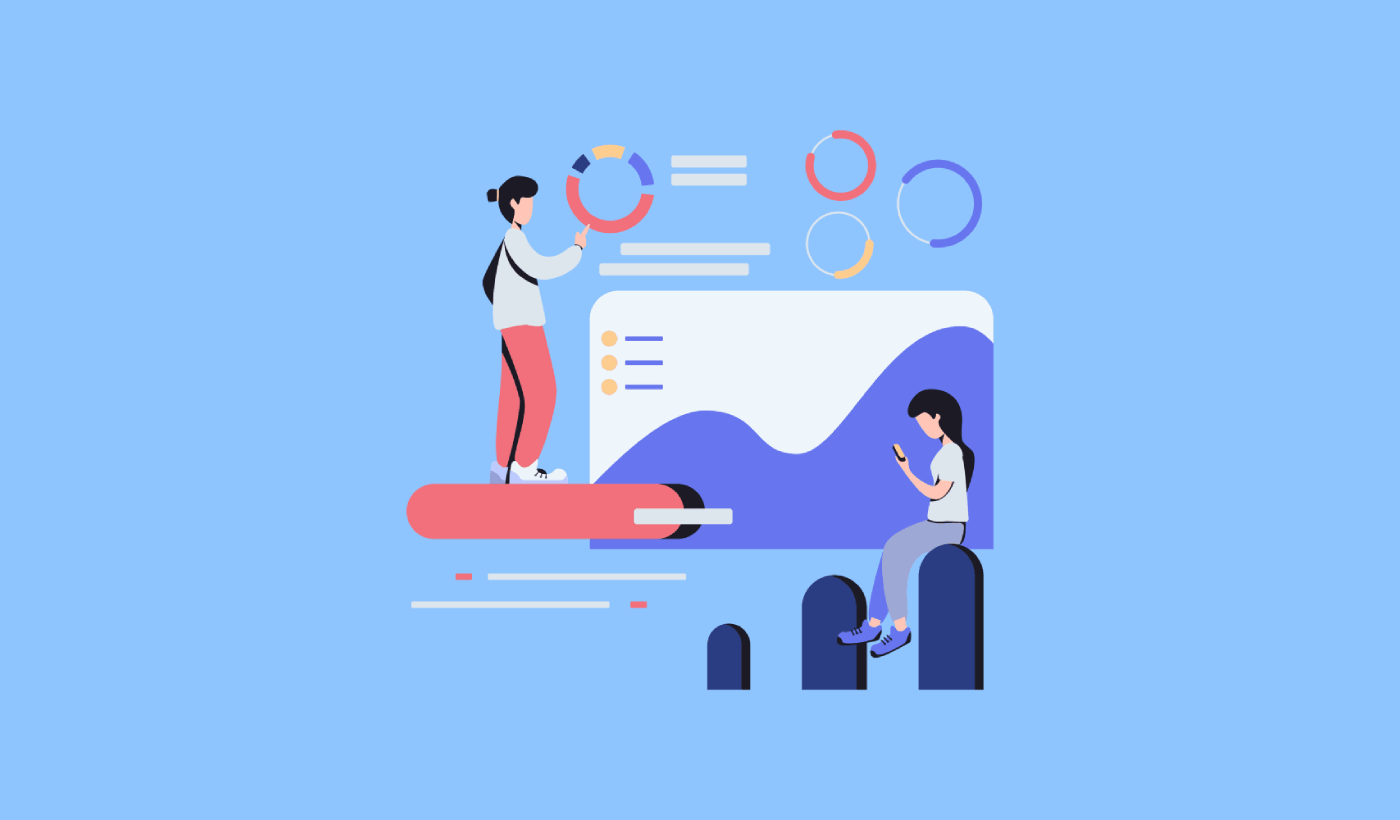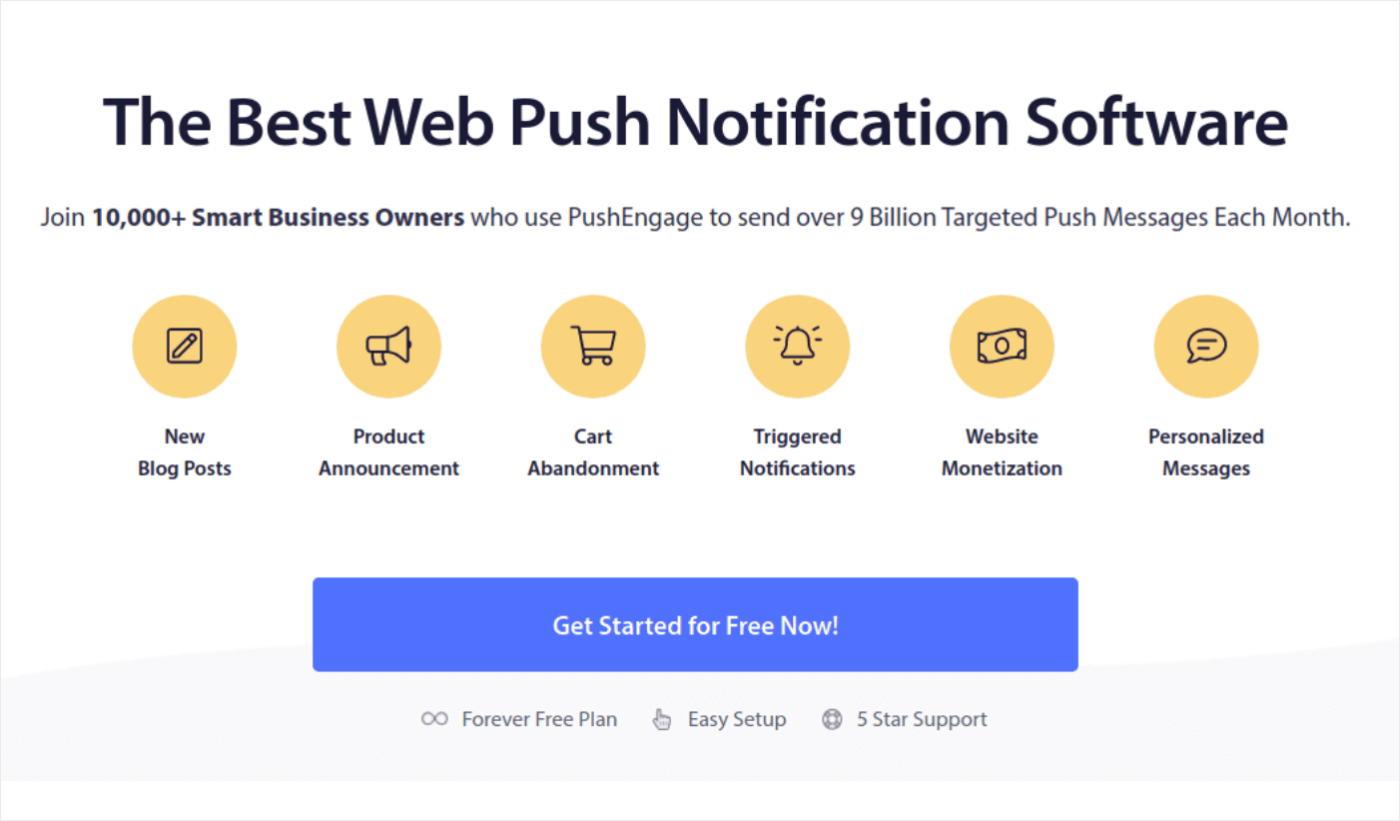Demographic segmentation examples can be a game-changer for your marketing campaigns.
Picture this: You’re a business with a diverse customer base, and you’re trying to craft a push campaign that resonates with everyone. Sounds like a tall order, right? But what if you could tailor your messages to each demographic group? That’s the power of demographic segmentation.
In this article, we’ll dive into some powerful examples of how demographic segmentation can supercharge your push campaigns. I’ll showcase how businesses like yours have leveraged demographic segmentation to skyrocket their engagement and conversion rates.
The coolest bit is that you can use these ideas for way more than your push campaigns. You can use these demographic segmentation examples for your email, SMS, or even your Facebook Messenger campaigns.
Are you ready? Let’s dive in.
Understanding Demographic Segmentation for Web Push
Before looking at demographic segmentation examples, let’s look at what it is.
Demographic segmentation is a strategy that categorizes your audience based on factors like age, gender, location, income, education, and more. Its aim is to fully understand your user’s individual characteristics to tailor your brand’s messages, enhancing the customer’s journey and overall user experience.
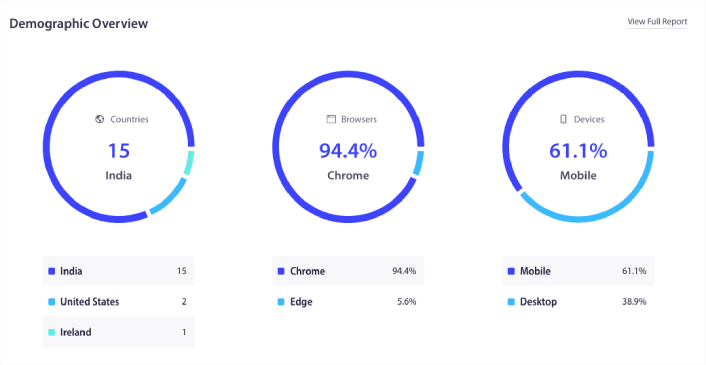
It’s often a miss if you broadcast generic push notifications to all users. While some might find it relevant, others could feel a disconnect with your brand. It’s a reality that in the fast-paced online sphere, every user counts.
Using our demographic segmentation examples, you can boost engagement and increase conversion rates. It allows you to create messages that specifically target your users’ needs, problems, and aspirations. It goes beyond the “spray and pray” approach, helping optimize resources and ad spend.
Demographic data is valuable for understanding online customer habits and you can use this data for behavioral segmentation as well. It aids in spotting potential markets and specific segments with higher buying tendencies. This crucial insight then drives the creation and delivery of products that your customers really need.
Occasion based segmentation is a smart marketing strategy that’s all about organizing and targeting your audience based on specific events or special moments in their lives.
It’s like recognizing that people act and like different things when, for instance, it’s a holiday, a big celebration, or a personal achievement.
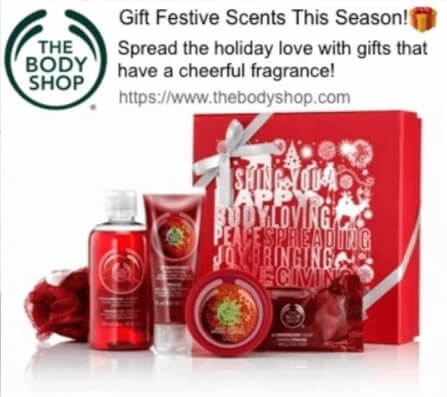
Your businesses can adjust marketing campaigns and messages to match what people are interested in during these special times. This personalized approach often leads to more engagement, better connections, and higher chances of turning interested folks into loyal customers, making your marketing efforts work even better.
Best Demographic Segmentation Examples for Push Campaigns
Knowing your audience’s demographics can greatly improve your push campaigns. Let’s explore some great demographic segmentation examples for your push notification campaigns.
#1. Tailoring Push Notifications by Age Differences
Platforms such as Spotify send content recommendations pretty much every day:

And Spotify uses age segmentation to target specific subscribers with content that they are more likely to enjoy.
But you don’t have to necessarily be Spotify to send content or product recommendations. Even you can use these demographic segmentation examples to send personalized notifications. For a news outlet, you can target specific news stories for different ages. And even for eCommerce stores, different ages gravitate towards different products.
For example, this is a cool way of targeting working professionals and getting some quick conversions:
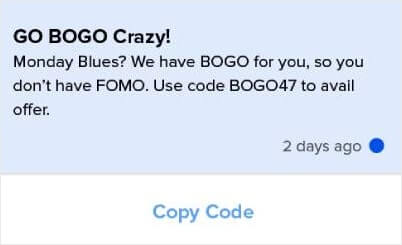
You can use the PushEngage Javascript API to send personalized push notifications and hook up your push campaigns to a Customer Relationship Management (CRM) tool.
#2. Engaging Different Genders with Personalized Push Notifications
Purchase habits change with the gender. So, of course, your campaigns need to change accordingly as well. Here’s one of the easiest demographic segmentation examples by Korner.space to target specifically women:
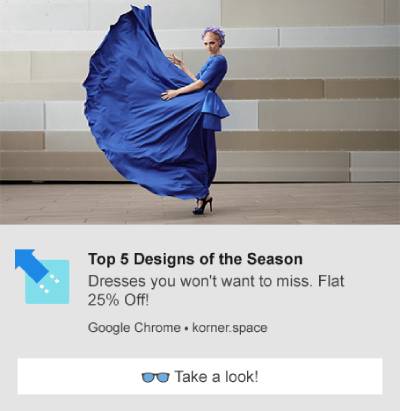
The welcome offer is your first interaction with your customers outside your own website. So, make it a good one with a nice offer that makes your customers feel valued. Or, you can even send out notifications by occasions that target a specific gender:
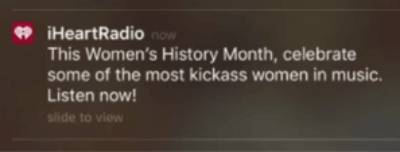
And this is a demographic segmentation example of a quick and easy way to be relevant to the women without spamming the men.
#3. Using Weather as a Key Segment for Push Campaigns
The worst possible feeling is to run into bad weather when you’re pumped up for a trip. You spent ages working up to that two-week vacation from work, you saved up for months for the dream trip to Goa, and you end up getting soaked in the rains.
Not cool.
That’s where a push notification like this one becomes super-memorable:
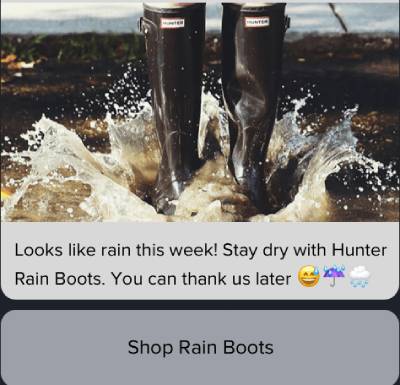
And you can set up campaigns like these demographic segmentation examples one using real-time trigger notifications.
#4. Income-Based Segmentation for Upsells and Cross Sells
Cross selling push notifications are eCommerce push notifications that automatically try to sell your customers products based on their purchase habits. A cross selling push notification campaign will automatically target specific customers to try and get them to buy other products that they may need.
Knowing your customer’s income range can be really helpful for cross selling and upselling campaigns. Of course, that’s not always easy to find. But based on the kind of products they purchase on your website, you can somewhat estimate the income range. Here’s an example:
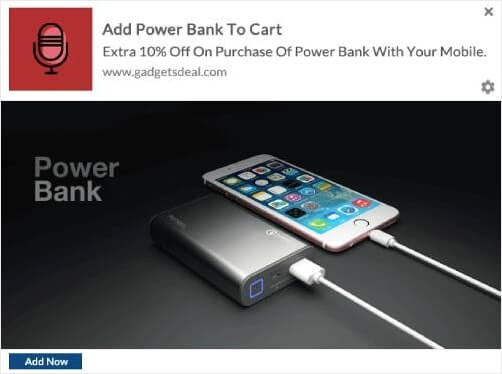
Typically, a cross sell is when you try to sell a product in the same price range as the products that your customers are already buying. So, if you understand the types of related products that your customers are likely to interested in, cross selling is easy.
Pro Tip: Think of tactics to include in your coupon marketing strategy to increase your conversions on cross selling push notifications.
#5. Education Segmentation to Boost Engagement With Students
Knowing educational levels in your customers can also help you out in a major way. Let’s think of some demographic segmentation examples to target students.
Sure, you can sell digital and informational products more easily with students. But you could create an offer targeting your locality for a brick and mortar store as well.
Let’s think of a personal styling business. What if you targeted the geolocations near you by creating offers for a college nearby?
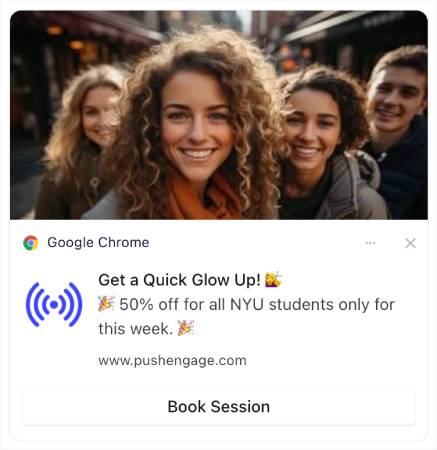
All you have to do is think of a good offer and set the targeting to a specific education level. Of course, sometimes you may not be able to directly create a segment from your existing push subscribers. But you can filter out the right audience using the right copywriting techniques.
Later on, you can have your customers manually sign up for a segment on page visit by asking them to visit a specific landing page and subscribe to your push notifications.
Or, you could create a segment and use a subscriber management widget to allow your subscribers to explicitly opt for a specific segment.
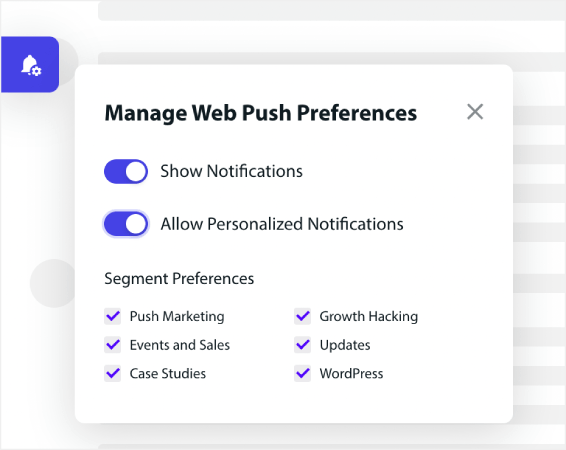
You could even create a special welcome offer for a specialized demographic using dynamic segments. So, this way, you can retarget the same audience much more easily the next time you launch an offer for them.
#6. Engaging Parents with Personalized Notifications
More often than not, readers don’t want to subscribe to the email newsletter.
In such cases, push notifications that offer ebooks and other lead magnets can help increase the audience engagement without them needing to give up their email addresses.
Here’s a cool way for you to target parents using demographic segments:
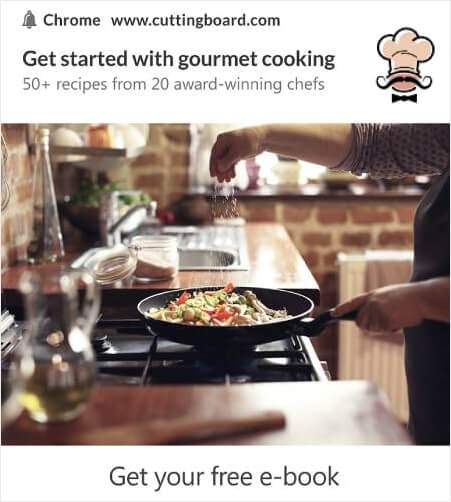
Unless your audience members are all pro chefs, you can bet that they struggle with keeping meals interesting for kids.
Note: I didn’t just stop at, “I want to target parents” and went one step further to solve an actual problem for them. The notification says nothing about parenting and yes, you can use your copy to target parents directly. But the key lesson is to use behavioral segmentation along with demographic segmentation.
At a later stage, when your subscriber is more deeply engaged, you can send them push notifications that convince them to opt in for the newsletter.
For many independent publishers, courses are a great way to boost revenue and engagement. Sometimes, publishers will even launch free ebooks and courses to improve their audience engagement and authority.
#7. Occupational Segmentation for Targeted Engagement
For publishers, there’s almost always official merchandise and goodies for hardcore fans. This is especially true if they’re known to host summits, podcasts, and industry events. And one of the easiest ways to get more engagement is to target people by their occupation.
Search Engine Journal sends out email blasts pretty regularly to all their subscribers. One thing that they do a lot of is webinars and podcasts. Of course, they have their own merchandise as well, but here’s a push notification example for a podcast e-vite:
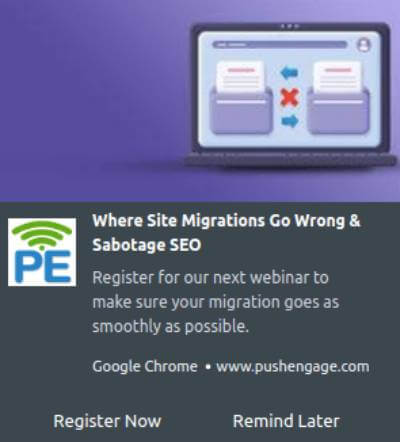
And you can send drip push notification campaigns to generate interest over a period of time. Of course, this works best for B2B sales more often, but you can use this idea for direct to consumer sales as well.
How to Use Demographic Segmentation for Push Campaigns
Before you start using these demographic segmentation examples for push notifications, you need to collect push subscribers. If you’re not collecting push subscribers already, you need to stop missing out right now. We recommend that you use PushEngage to start collecting push subscribers right now.
PushEngage is the #1 push notifications plugin in the world. If you compare it to the other best push notification services, you’ll see that it clearly comes out on top.
Push notifications help you grow your website traffic and engagement on autopilot. And if you’re running an online store, PushEngage also helps you grow your sales by helping you create automated eCommerce push notifications.
You can get started for free, but if you’re serious about growing your business, you should buy a paid plan. Also, before buying any push notification service, you should check out this guide to push notification costs.
Here’s a quick glance at what you get with PushEngage:
- High-converting automated campaigns
- Multiple targeting and campaign scheduling options
- Goal tracking and advanced analytics
- Intelligent A/B testing
- A Dedicated Success Manager
You’ll see that PushEngage is hands down the best bet if you want to build traffic, engagement, and sales for your business. And if you’re on a budget, you can always get a little bit creative with your push notifications.
And lots more!
Collecting Demographic Data for Retargeting
One of the best things about push notifications is that you automatically collect demographic data anyway. So, you can use that to create campaigns that cater to local events and occasions.
You can also create dynamic segments to retarget your subscribers based on their behavior.
And if you’re looking to quickly grow your push subscribers, you should use your other marketing channels to ask people to subscribe to your push campaigns. One very cool way to pull this off is to use a blog subscription widget on your site that collects push subscribers:
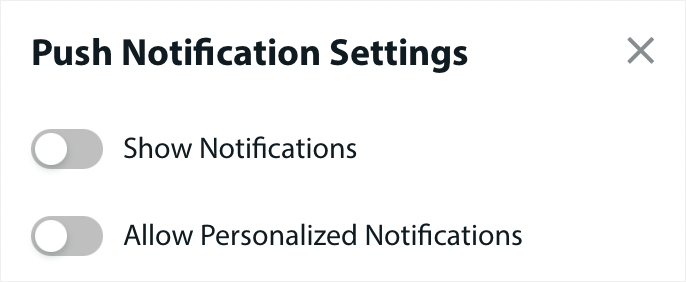
You can even create popups to collect push subscribers on your site like this one:
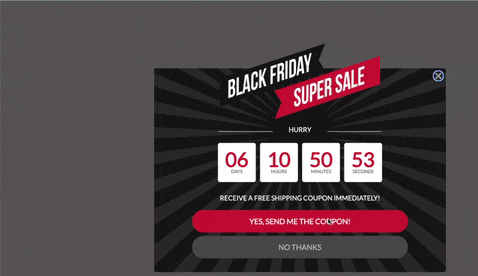
Or, you can even create landing pages with a click to subscribe button that collect push subscribers.
Creating Targeted Content Using Demographic Segmentation
An easy way to boost your conversions is to set up retargeting push campaigns.
If you’re not sending the notification to all subscribers, you’ll need to create an Audience Group. For instance, if you want to target the subscribers who didn’t click on the broadcast to everyone, you’ll need to create a new Audience Group.
In your WordPress dashboard, go to Audience » Audience Groups and click Create New Audience Group:
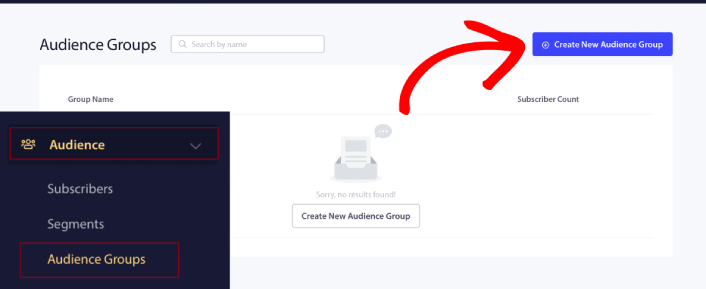
If you want to target subscribers who clicked on your last notification, you can create another Audience Group.
Filter your subscribers by Last click date after the date you sent your previous notification AND before the date you want to send your next notification:
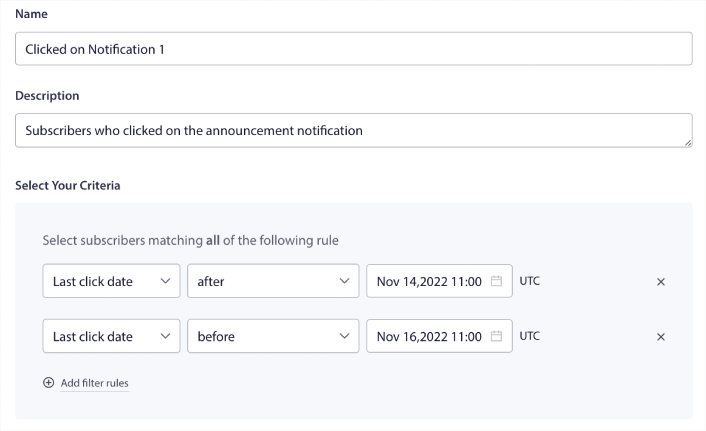
You can add AND criteria to your filter by clicking on Add filter rules. A filter like this is great for sending cross-selling push notifications. The outcome of these Audience Groups is more granular targeting. So, each time, you can send different offers to improve your conversion rates.
Timing Your Push Campaigns for the Perfect Demography
Next, you’ll need to learn how to schedule your push campaigns. Every time you create a new push notification on PushEngage, you get the option to schedule it by date and time:
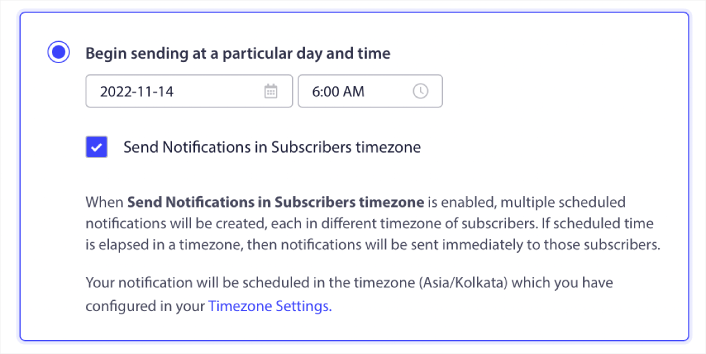
You can even schedule recurring push notifications for repeat events such as weekly sales:
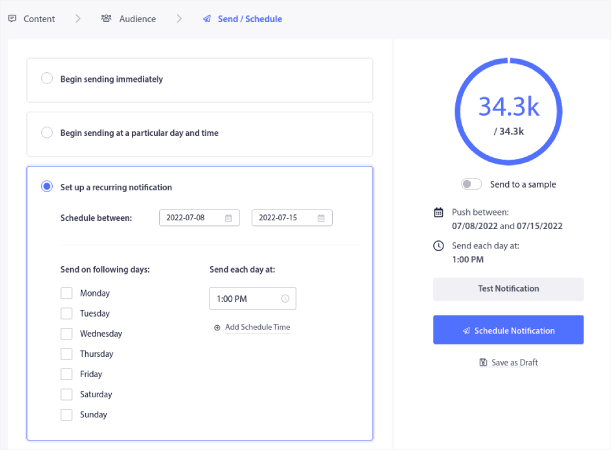
If you’d like to select for how long the repeat schedule will work, click on the calendar next to Schedule Between to set the dates. And that’s all there is to it! Now, all you have to do is find the best time to send push notifications and use our demographic segmentation examples.
Benefits of Demographic Segmentation for Push Campaigns
Now that you’ve seen a bunch of demographic segmentation examples, let’s revisit some of the benefits for your push campaigns.
Imagine this: You’re launching a new push campaign. You’ve got a killer headline, an irresistible offer, and a call-to-action that’s sure to convert. But there’s one problem: Your campaign is falling flat. Why? Because you’re treating all your subscribers the same.
Enter demographic segmentation. This powerful strategy allows you to divide your subscriber base into smaller groups based on specific characteristics like age, gender, location, and more. And the benefits? They’re game-changing.
- Personalized Messaging: With demographic segmentation, you can tailor your push notifications to match the interests and needs of each demographic group. This means more relevant messages, higher engagement rates, and ultimately, more conversions.
- Improved Subscriber Experience: Nobody likes receiving irrelevant notifications. By segmenting your subscribers, you ensure that they only receive notifications that are relevant and valuable to them. This leads to a better subscriber experience and reduces the chances of unsubscriptions.
- Increased ROI: By sending targeted notifications, you increase the likelihood of your subscribers taking the desired action. This leads to higher conversion rates and a better return on investment for your push campaigns.
- Insightful Analytics: Demographic segmentation also gives you valuable insights into the behavior and preferences of your different demographic groups. You can use this data to further refine your push campaigns and make them even more effective.
So, are you ready to take your push campaigns to the next level? Start leveraging demographic segmentation today and watch your engagement and conversion rates soar!
Personalization Techniques for Push Notifications
Let’s talk about how to best use the demographic segmentation examples for your push campaigns now.
Segments are a really great way to send targeted push campaigns. And it should be a big part of your push notification marketing strategy. One of the coolest things about push notifications is that you can create dynamic segments for higher engagement rates.
You can easily get started with Geographic segmentation:
In the PushEngage dashboard, you can see the countries where your subscribers are located under Demographic Overview.
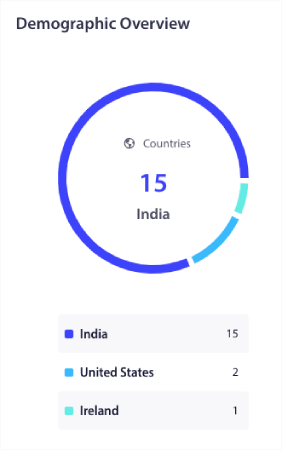
You can use this list of countries to create geographic segments. Geographic segmentation allows you to:
- Send push campaigns in your subscribers’ timezones for better engagement
- Run local offers that are only relevant to that customer segment for higher conversion rates
- Create campaigns in local languages for higher click rates
Or, you can try demographic segmentation:

You can use this data to create demographic segments based on the browser and device that your subscribers are using. Whenever you send a push broadcast or a campaign, simply scroll down to Send to Custom Audience and add the targeting rules.
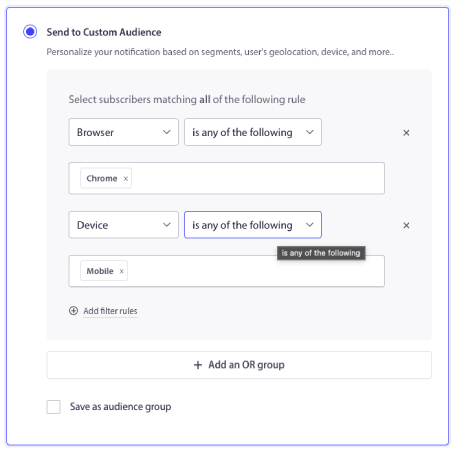
As with geographic segmentation, you don’t need to create a new segment to target audience demographics. These are all default segments. You can even create behavioral segments. Head over to Audience » Segments and click on Create a New Segment:
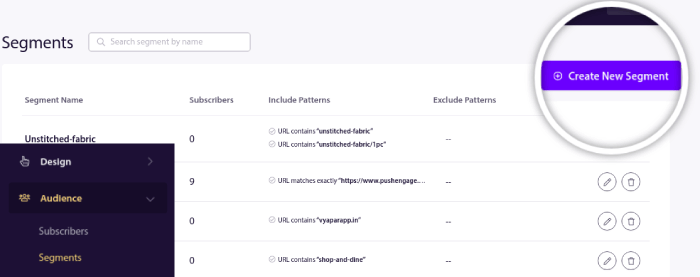
And create a rule that segments your subscribers automatically based on the URLs they’re browsing:
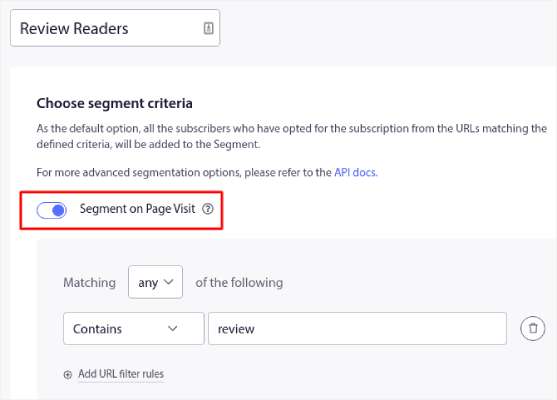
In the example, we created a segment called “Sample Segment” that segments subscribers automatically when they visit URLs on your site with the word “examples” in it. You can pretty much use any keyword you like here.
And that’s not all. You can create multiple segments automatically to send targeted push campaigns. Check out our article on how to segment your subscribers automatically.
Creating Compelling Push Notification Copy
As you’ve already seen in our demographic segmentation examples, the copywriting in your push campaigns can make all the difference in the world. For any push campaign, you should remember:
Personalized Recommendations + Story-Driven Copy = High Engagement.
We have an entire list of push notification copy examples you can use. Go ahead and check that out. And if you need some help with creating push campaigns, you should check out our templates.
Go to Campaigns » Push Broadcasts and click on the Choose From Templates button:

And you can select a push notification template from our library of proven campaigns:
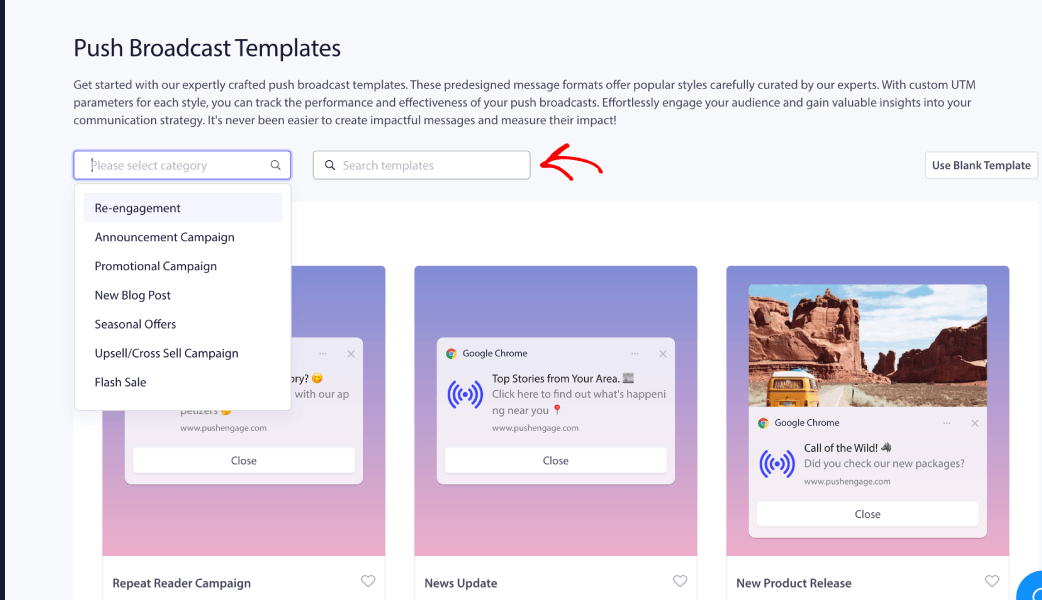
And if you need more inspiration, you should check out this list of push notification examples. Also make sure that to write the copy within push notification character limits.
Compliance and Privacy for Our Demographic Segmentation Examples
According to GDPR, you must obtain explicit consent before collecting or processing any personal information of an EU resident or citizen.
Now, push notifications are a lot like emails but even more constrained. You can ONLY send out push notifications to your subscribers. Unlike emails, you can’t send a single push notification randomly to someone who’s not subscribed.
Where GDPR meets push notification software is that you’re collecting subscribers. So, in a sense, you are collecting consumer data.
Of course, it’s not the same as an email opt-in. With an email opt-in, you have to capture the email address, but you can capture a LOT of additional data. Take a look at this one by HubSpot:
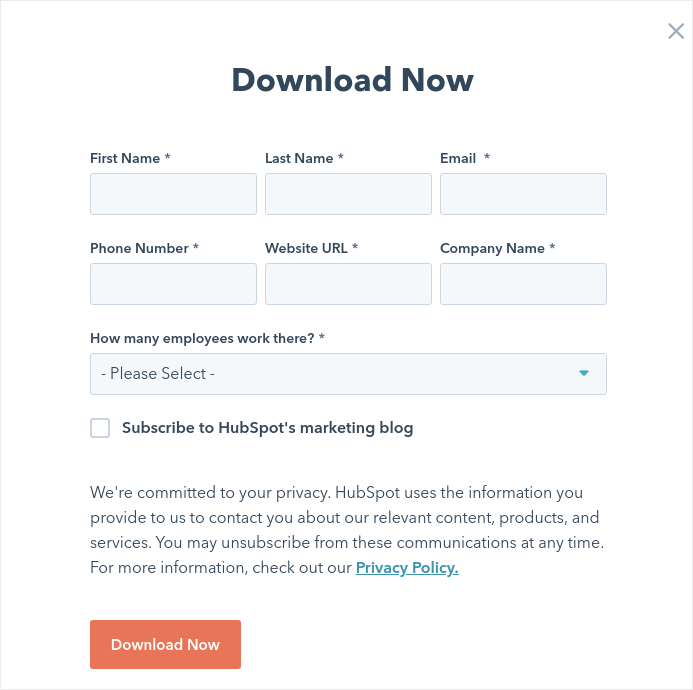
But with push notifications, you capture the combination of the device and the IP address to generate a key that is unique to the customer’s device. That’s what happens when people opt for your push notifications by clicking ‘Allow’:
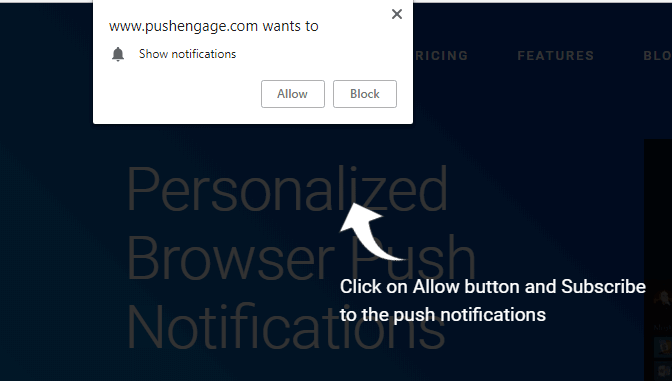
Additionally, PushEngage can store the geolocation of your subscribers so that you can create personalized push notification campaigns. This includes the country, state, and city at the time of subscription.
But as you can probably understand, this is entirely based on consent. When someone opts for push notifications, they give you consent to send them marketing notifications. So, our demographic segmentation examples for push notifications are already compliant with GDPR by definition because they operate on a consent-first paradigm.
Measuring and Refining Results
Push notification A/B testing is a method of optimizing your conversions from push notification campaigns. You can choose to optimize different parts of your push notifications based on what kind of results you want to improve on using the demographic segmentation examples.
It’s time to answer the bigger question with push notification A/B testing. What can you split test in a push notification?
The most common performance metrics for push notifications are:
- Click rate: The click rate on a push notification is how often your subscribers saw your push notification and then clicked on it.
- View rate: The view rate of a push notification is how often a subscriber received your push notification and saw it before it expired.
- Goal conversions: You can set goals for your campaign and set up goal tracking for your campaigns. The goal conversions is a measure of how many times you achieved your goal.
To increase your view rates, you want to use a large image in your push notifications. Using images in your notifications instantly makes it more appealing.
Add a Push Notification Broadcast
Head over to your PushEngage dashboard and go to Campaign » Push Broadcasts and click on the Create a New Push Broadcast button:

Under the Content tab, add your push notification content:
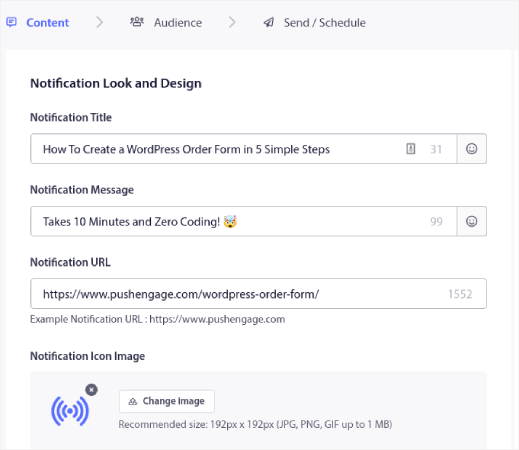
Add a Push Notification A/B Test
Click on the Add A/B Test link to create an A/B test for your push notification instantly:

And then, you can simply create two versions of you push notification:
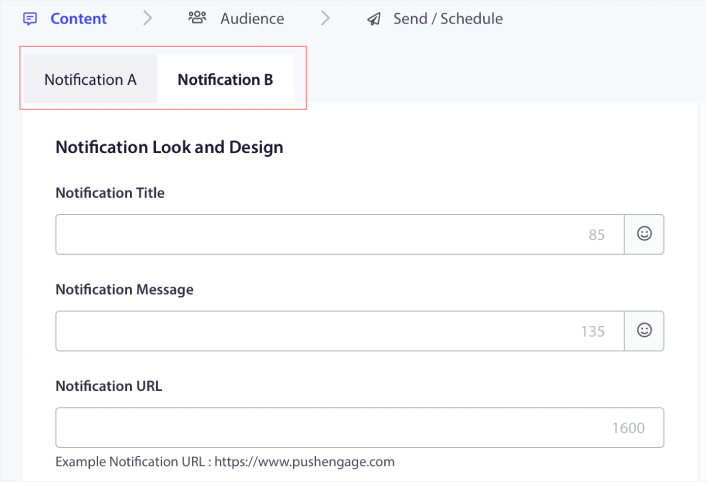
And you can change anything you like in your version B. If you scroll down, you can even split test your push notification action buttons. Once you’re done setting up the content in the two versions, click the Save and Select Segments button.
You can select a custom audience here:
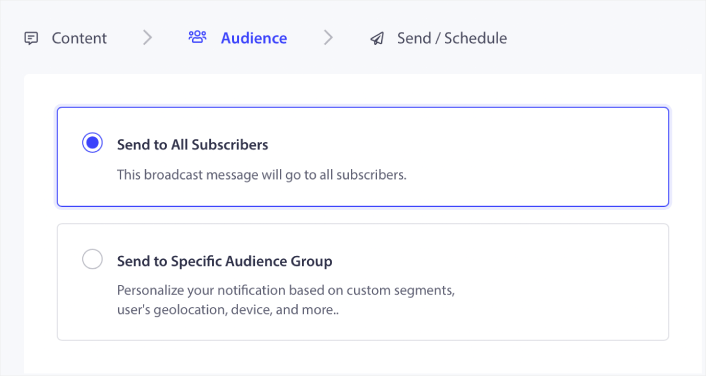
Or, you can send it to all your push notification subscribers. When you’re done, click the Send/Schedule button.
Set Up an Intelligent A/B Test
In Intelligent A/B Testing, you run the test on a part of your total audience. We recommend running a Intelligent A/B Test on 30% of your audience. This way, you send version A to 15% of your audience, and version B to another 15%. Whichever push notification performs better automatically gets sent to the rest of your audience.
So, in Intelligent A/B Testing, you can send the winning push notification to 85% of your audience instead of sending it to 50%. This improves your overall campaign performance instantly and it’s super simple to set up.
Here, you can enable Intelligent A/B Testing:
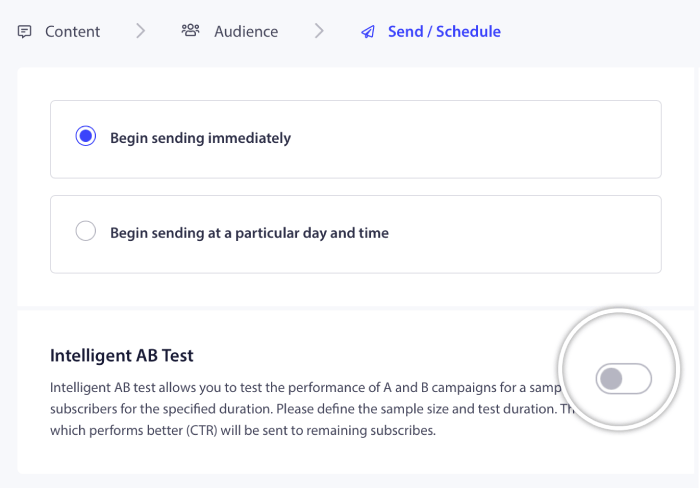
Turn the Intelligent A/B test on and set the sample size for the test.
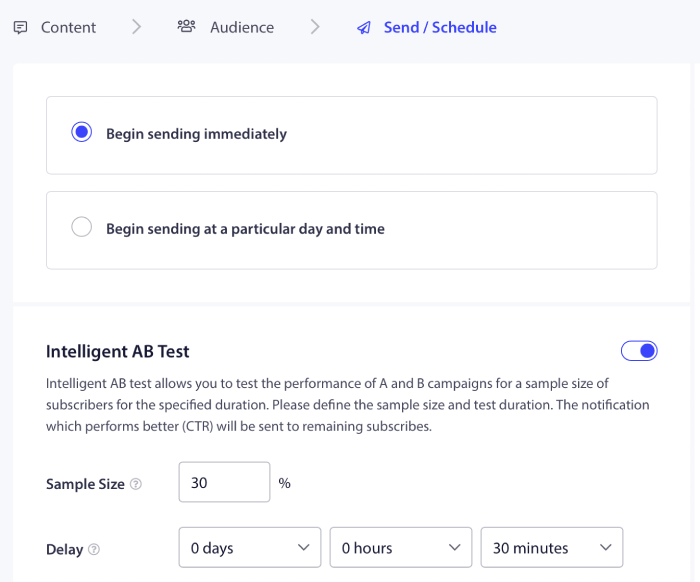
And just schedule or send a push notification from our demographic segmentation examples. You’re done!
Continuous Optimization Techniques
Every push notification campaign or single broadcast has its own analytics data. What you want to look at are:
- Click through rate (CTR): The CTR is the percentage of people who saw your push notification and then clicked on it.
- Goal count: Your goal count is the number of people who took the action you wanted after clicking on your notification.
- Revenue: We highly recommend having a revenue goal for your push campaigns, especially is you’re running an eCommerce store.
There are some other metrics you can look at:
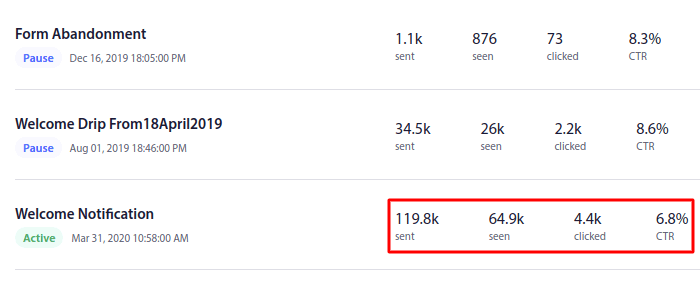
Push notification opt-ins have very specific analytics as well.
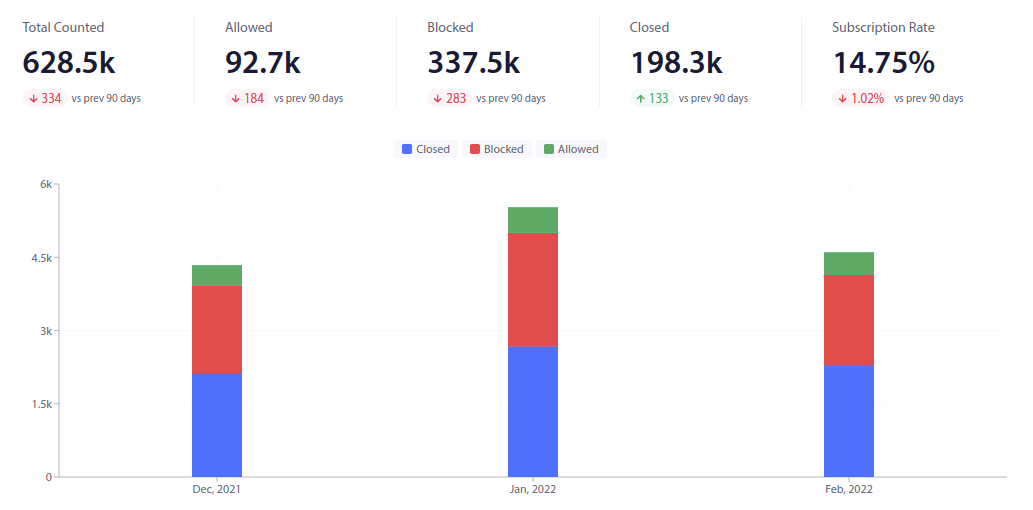
What you want to focus on is your subscription rate. The rest of the numbers can be a distraction if you’re a complete startup. Let’s break this down in simpler terms.
With Goal Tracking, you can track the ROI of your campaigns. For instance, if we set a revenue goal for purchases made on your site, goal-tracking with push notifications can track:
- The number of conversions
- And the dollar value
For every sale made from a push notification campaign!
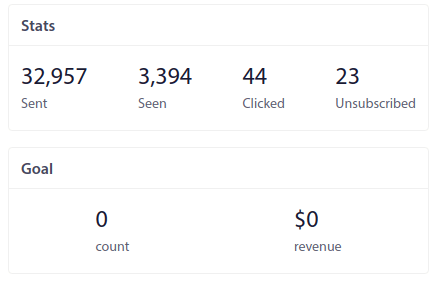
Based on this report, you can calculate the return on investment (ROI) of your campaigns.
Pro Tip: You can filter and sort your push notifications to find winning campaigns. It’s an easy way to understand what’s working for your audience.
What to Do With These Demographic Segmentation Examples
Now that you’ve seen a bunch of demographic segmentation examples along with real best practices from industry leaders, it’s time to set up your own campaigns.
Getting started with targeted push notifications can seem intimidating. But if you keep an eye on goal tracking and analytics, you should be fine. More importantly, you’ll make a lot more profit with the help of push notification campaigns.
Again, these ideas aren’t meant just for push campaigns but for any marketing channels that allow you to segment your subscribers. We recommend starting with push campaigns because push notifications are super cost-effective.
Here are a few cool resources to get you started:
- How to Use Retargeting Push Notifications to 2x Your Revenue
- How to Sort Your Push Notifications and Find Winning Campaigns
- How to Clean Up Push Notifications Subscriber Lists (Easy)
- How to Automatically Send RSS Push Notifications
- How to Use Push Notifications to Promote a News Site
- How to Use Cross Selling Push Notifications to 2x Your Sales
- How to Use Browse Abandonment Push Notifications (4 Steps)
If you’re new to push notifications, you should try out PushEngage. PushEngage is the #1 push notification software in the market. And your campaigns will be in safe hands.
So, if you haven’t already, get started with PushEngage today!
